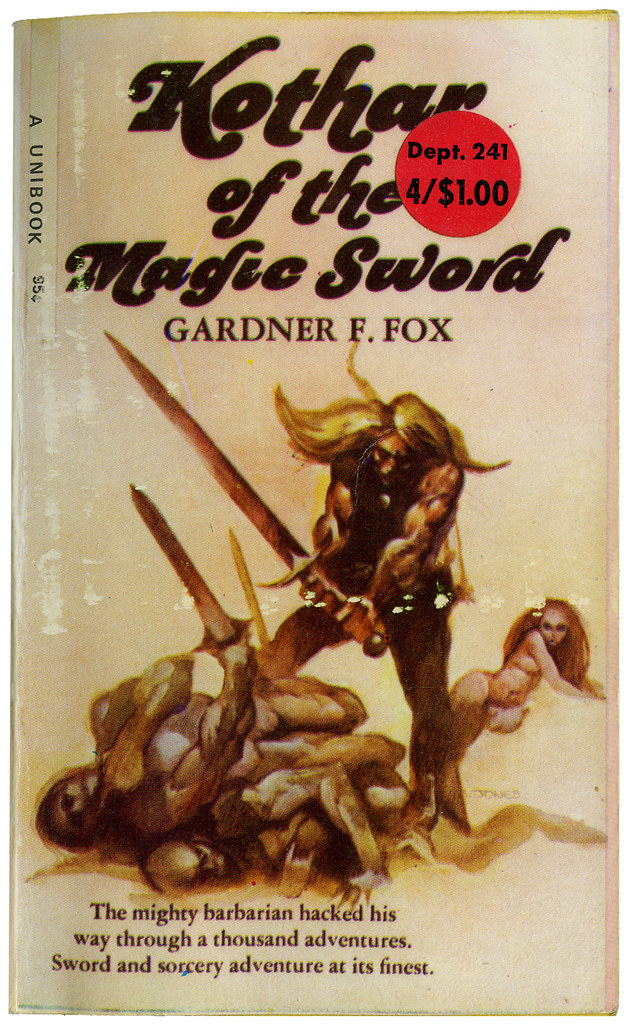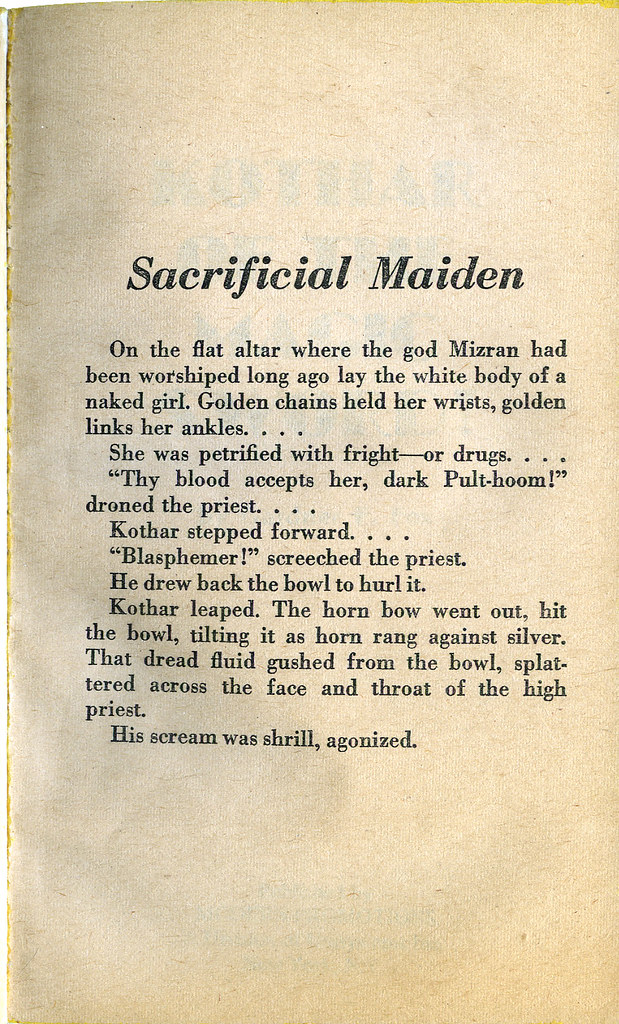I've often mentioned the books that used to reside at the family cabin in the Sierra's. I don't know if I've ever said that 95% of the books came from someone else's cabin. Friends sold their cabin in 1970 and we inherited all sorts of stuff, including the odd book below.
No, I would never buy a book about barbarians hacking people with swords. I wouldn't even pick up a book with this cover, even if there was a 4 for a buck offer. I'm just not into wizards, barbarians, swords, magic, etc. I know there's a whole market for this sort of stuff, but to me it's mind-numbing.
And the cover illustration just looks like a cheap rip-off of Frank Frazetta.
But what of the man who wrote this, Gardner Francis Cooper Fox? Now there's an interesting story. The following copy is from Wikipedia.
 Gardner Francis Cooper Fox (May 20, 1911, Brooklyn, New York – December 24, 1986) was an American writer best known for creating numerous comic book characters for DC Comics. Comic-book historians estimate that he wrote over 4,000 comics stories.
Gardner Francis Cooper Fox (May 20, 1911, Brooklyn, New York – December 24, 1986) was an American writer best known for creating numerous comic book characters for DC Comics. Comic-book historians estimate that he wrote over 4,000 comics stories.
(Image to left: by Gil Kane)
Gardner F. Fox was born in Brooklyn, New York on May 20, 1911. Fox recalled being inspired at an early age by the great fantasy fiction writers. On or about his eleventh birthday, he "had gotten The Gods of Mars and The Warlord of Mars" by Edgar Rice Burroughs, books which "opened up a complete new world for me." In a time before comics existed, he "read all of Burroughs, Harold Lamb, Talbot Mundy," maintaining copies "at home in my library" some 50 years later.Fox received a law degree from St. John's College and was admitted to the New York bar in 1935. He practiced for about two years, but as the Great Depression dragged on he began writing for DC Comics editor Vin Sullivan. Debuting as a writer in the pages of Detective Comics, Fox "intermittently contributed tales to nearly every book in the DC lineup during the Golden Age." He was also a frequent contributor of prose stories to the pulp science fiction magazines of the 1930s and 1940s.A polymath, Fox sprinkled his strips with numerous real-world historical, scientific, and mythological references, once saying, "Knowledge is kind of a hobby with me." For instance, in the span of a year's worth of Atom stories, Fox tackled the 1956 Hungarian revolution, the space race, 18th-century England, miniature card painting, Norse mythology, and numismatics. He revealed in letters to fan Jerry Bails that he kept large troves of reference material, mentioning in 1971 that:"I maintain two file cabinets chock full of stuff. And the attic is crammed with books and magazines....Everything about science, nature, or unusual facts, I can go to my files or the at least 2,000 books that I have."
For years Fox worked for DC Comics writing Sandman, Batman, The Flash, Hawkman, and The Justice Society of America.
Fox stopped receiving work from DC in 1968, when the comics company refused to give health insurance and other benefits to its older creators. Fox, who had written a number of historical adventure, mystery and science fiction novels in the 1940s and the 1950s, began to produce novels full time, both under his own name and several pseudonyms. He produced a small number of comics during this period, but predominantly focused on novels, writing over 100 in genres such as science fiction, sword and sorcery, espionage, crime, fantasy, romance, western, and historical fiction.
According to this Wikipedia article Fox can be credited with creating around 1500 stories for DC comics "making him the second most prolific DC creator by a considerable margin over his nearest rival."
He died on December 24, 1989.
Among his output was the modern novelisation of the Irwin Allen production of Jules Verne's Five Weeks in a Balloon, two books in the "Llarn" series; five books about the barbarian swordsman Kothar (starting in 1969 with the anthology Kothar—Barbarian Swordsman) and four books about the adventures of "Kyrik," starting with Warlock Warrior (1975).Strangely, there is no copyright page in this paperback. It doesn't even look like it was torn out. Standard placement of copyright information is on the verso of the title page. According to Amazon this edition came out in 1969. That would fit in with when it ended up at the cabin.
I can guarantee that I won't be reading this book.
UPDATE: Thanks to a commenter who took umbrage to my statement about the illustrator of this cover, I now know the name of the illustrator, Jeff Jones. The commenter is correct to say that the illustrator was good as you'll see here in a piece written about his work. I still maintain that what the publisher was hunting for was a knock-off of Frank Frazetta. Having worked in publishing for decades I know what it's like when an editor gets an idea in their head which doesn't correspond to their budget. They say "get me..." the latest and greatest when what they really mean is get me someone who can do what they do for half the price.
UPDATE: Thanks to a commenter who took umbrage to my statement about the illustrator of this cover, I now know the name of the illustrator, Jeff Jones. The commenter is correct to say that the illustrator was good as you'll see here in a piece written about his work. I still maintain that what the publisher was hunting for was a knock-off of Frank Frazetta. Having worked in publishing for decades I know what it's like when an editor gets an idea in their head which doesn't correspond to their budget. They say "get me..." the latest and greatest when what they really mean is get me someone who can do what they do for half the price.



The cover is not "a cheap rip off of Frank Frazetta". Its by an amazing artist Jeff Jones who Frazetta spoke very highly of.
ReplyDeleteIf he was a well respected artist that's nice to hear, but the reproduction on this book still makes it look pretty bad.
ReplyDelete